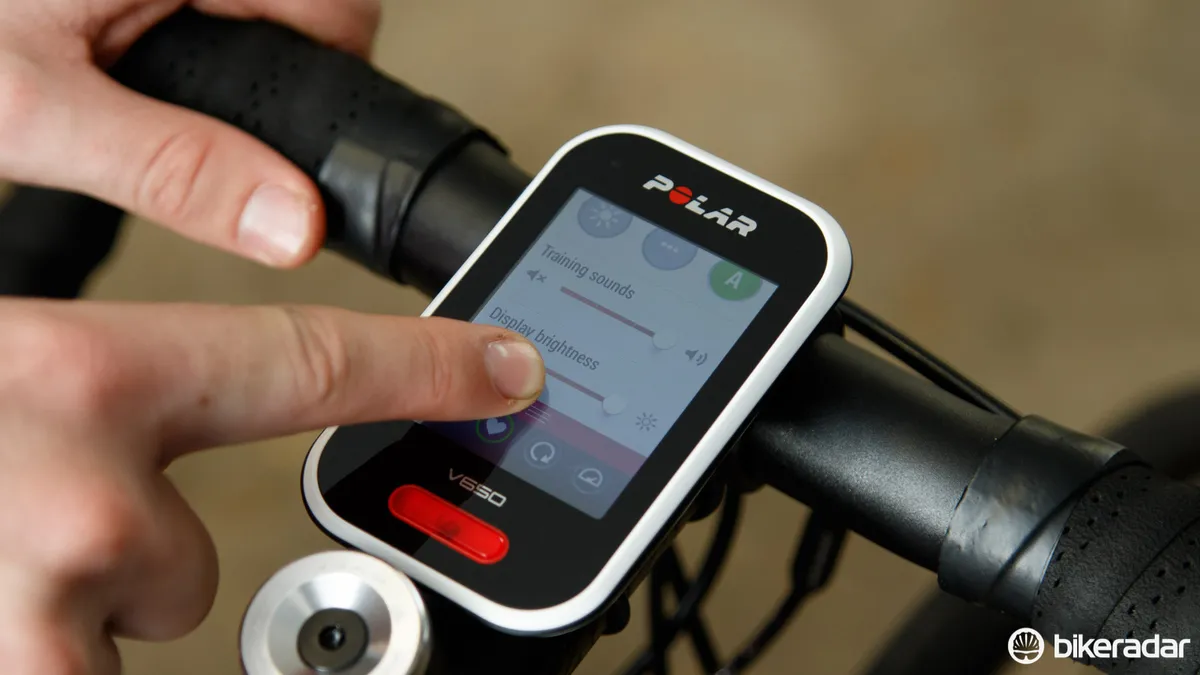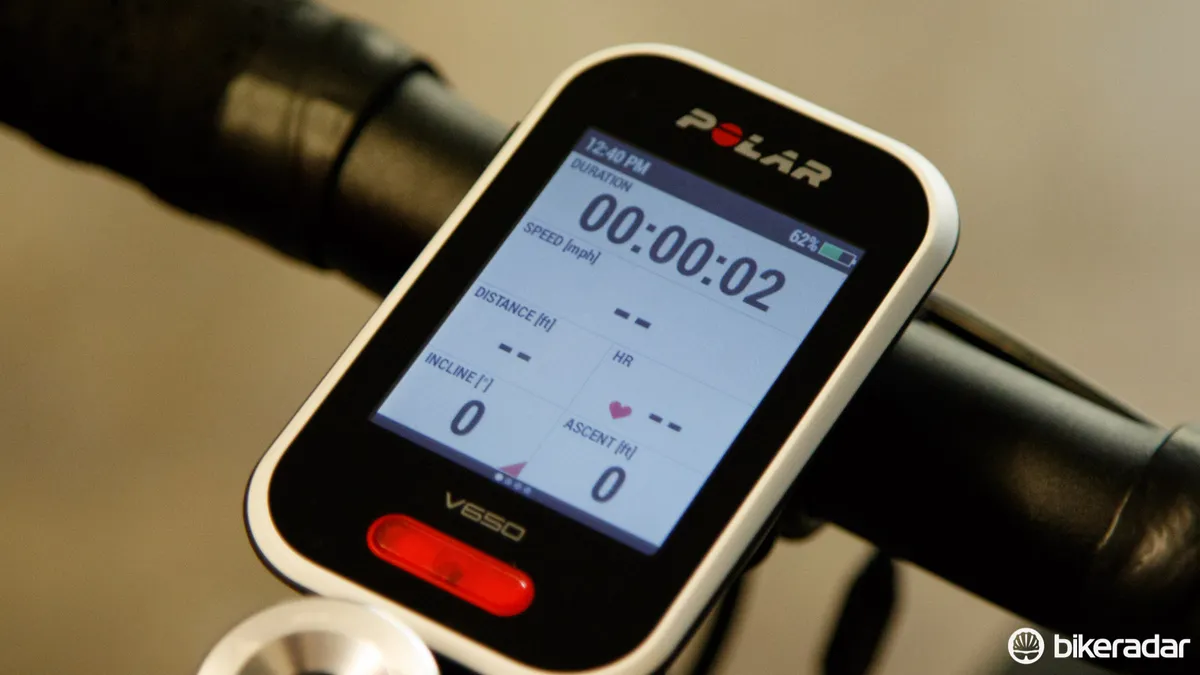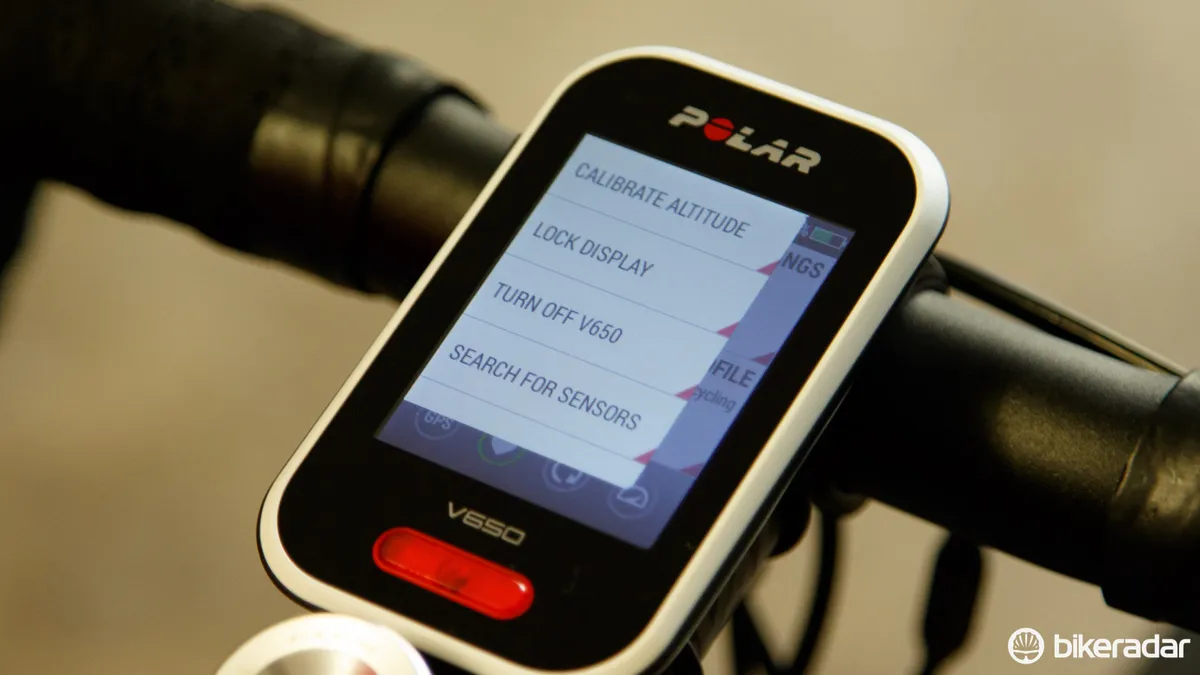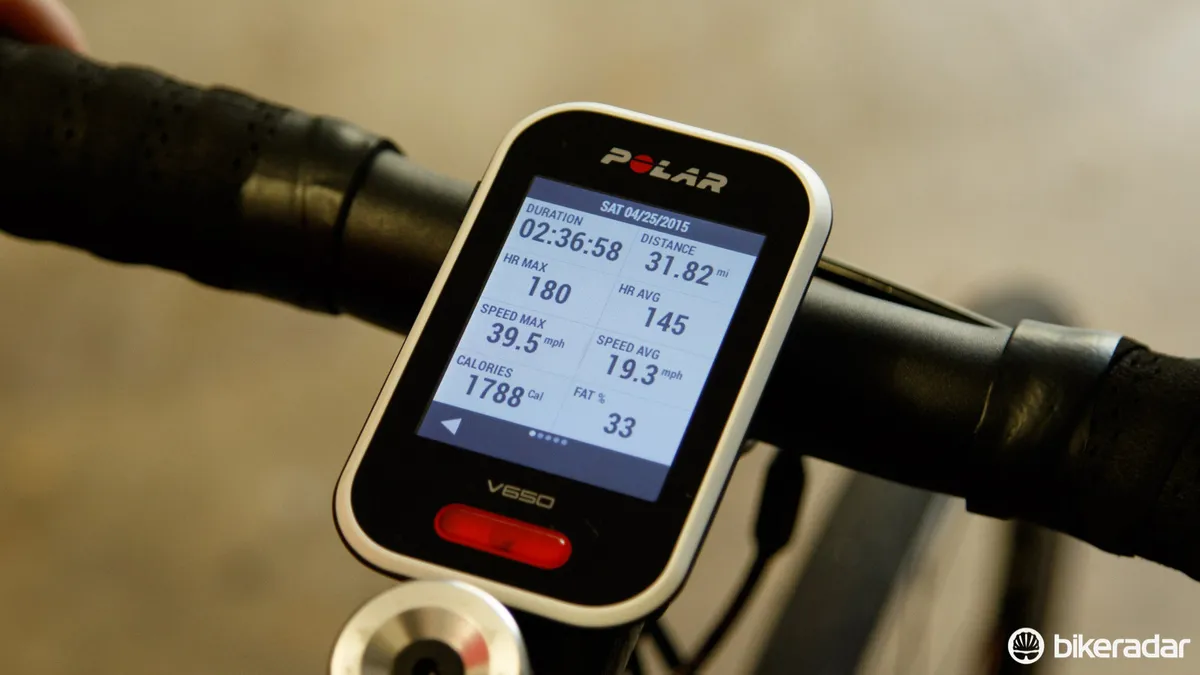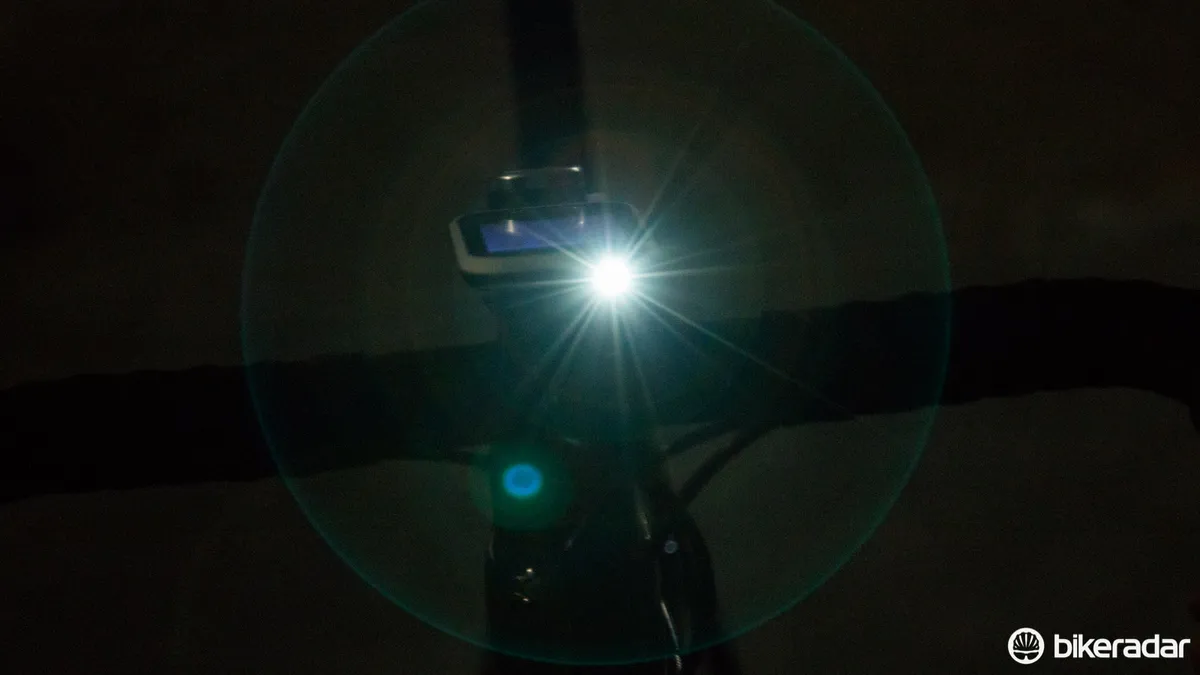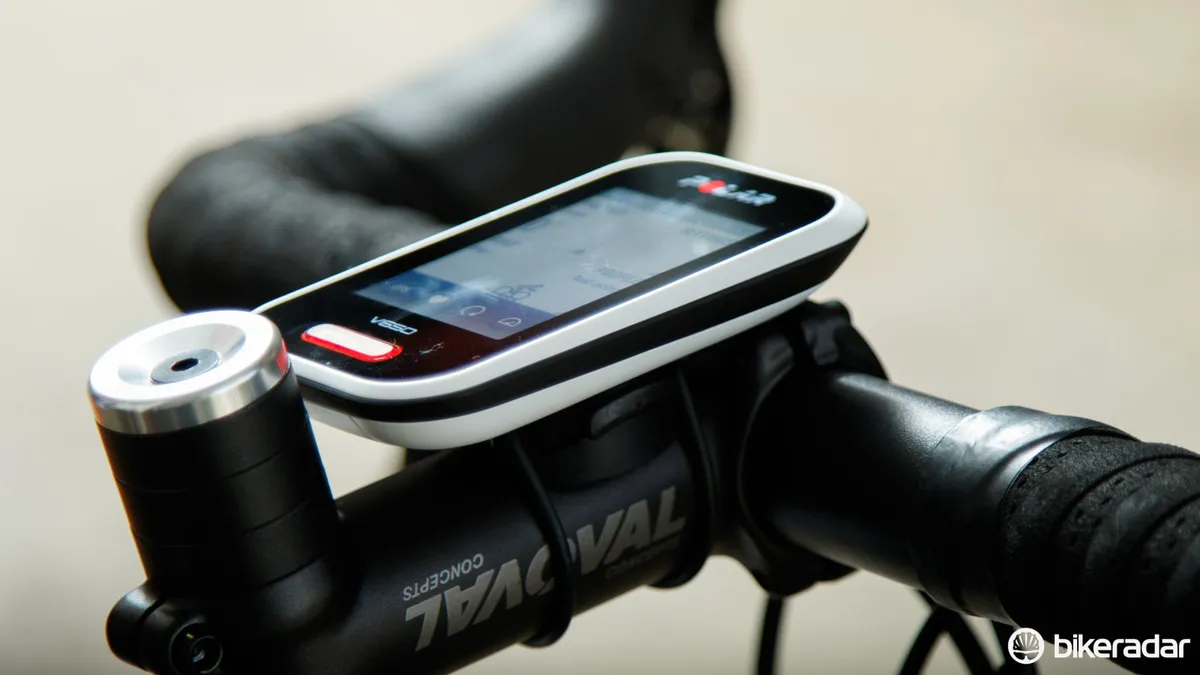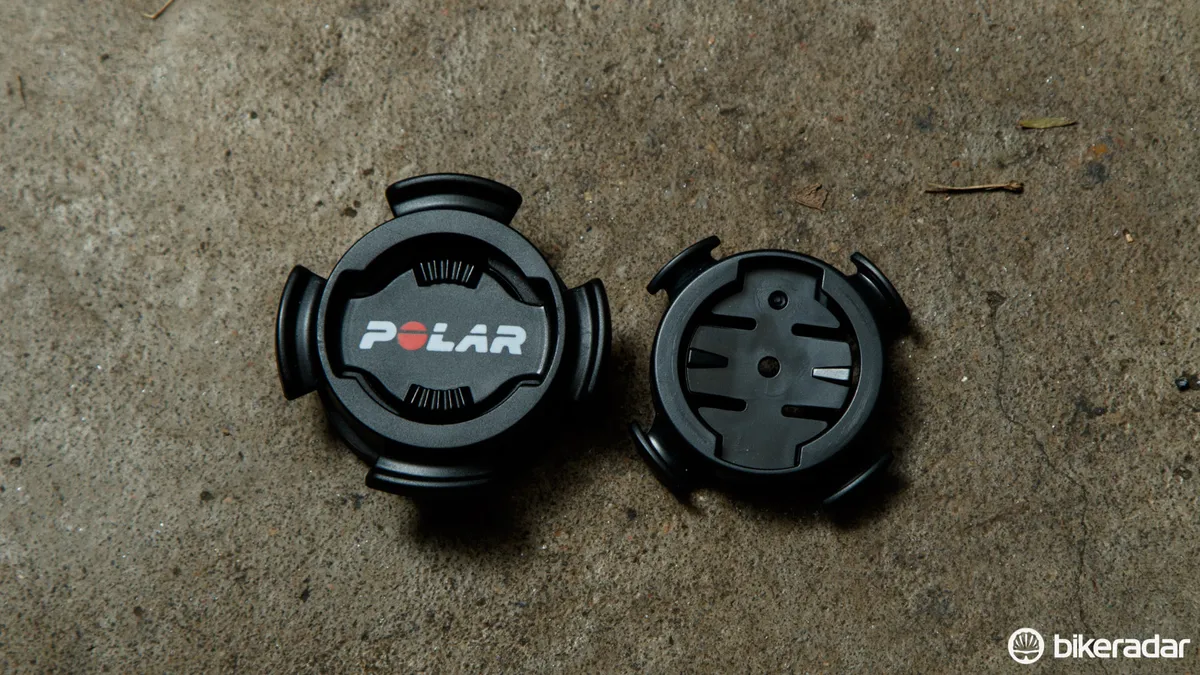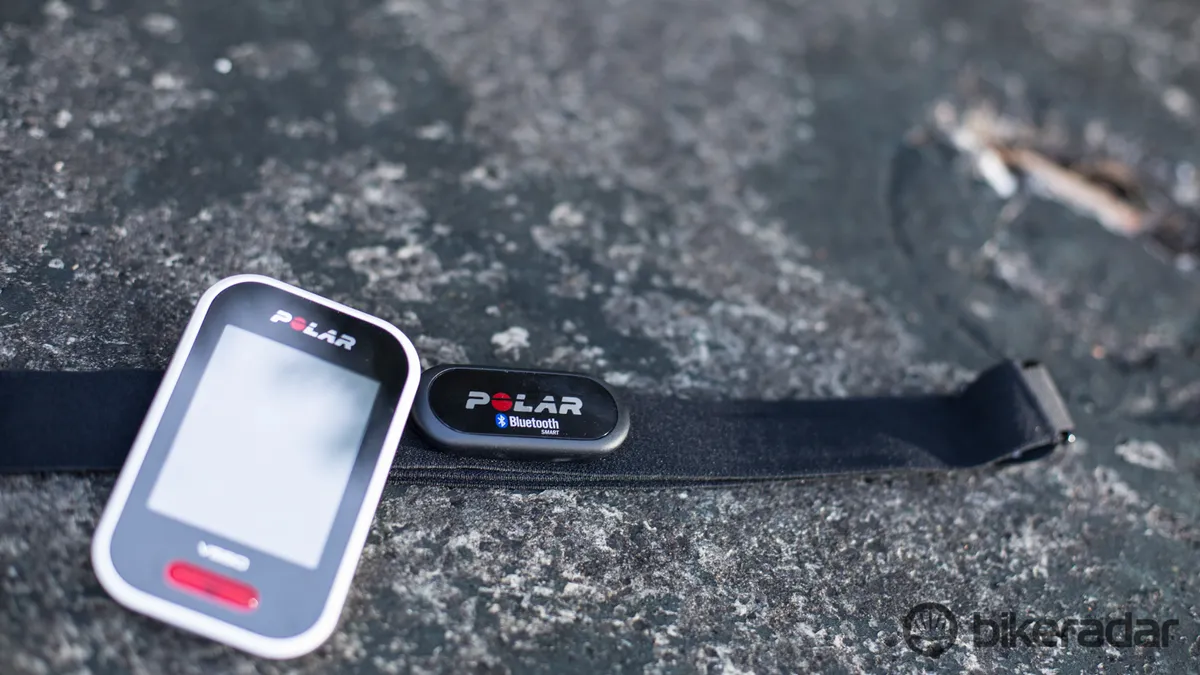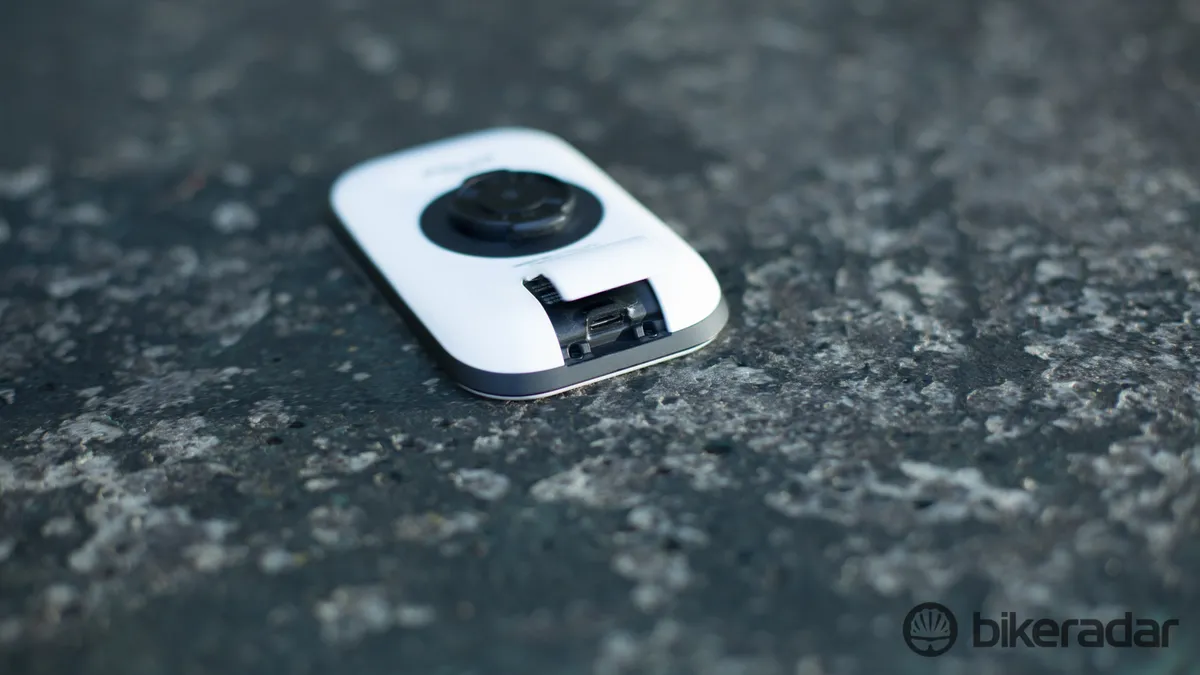It has been some time since Finnish company Polar, known best for its heart rate watches, released its CS500+ cycling specific computer. We had high hopes for the new and well-priced V650, which sees Polar throwing its hat back into the cycling computer game and recently claimed a Red Dot Design award. Unfortunately it left us impatiently awaiting some major firmware upgrades.
The competition among the cycling computer market is pretty stiff these days, and it takes something special to stand out from the market-conquering Garmin, not to mention the disruptive likes of Fitbit, Apple and Samsung.
- Highs: Smart design, high quality screen, easy viewing, in-device graphs simplify information
- Lows: Held back by firmware, no ANT+ compatibility, currently no mapping ability, currently only works with Polar power meter, currently no auto-upload to Strava
- Buy if: You're after an intuitive device that's easy to read and provides detailed heart rate training information
Design
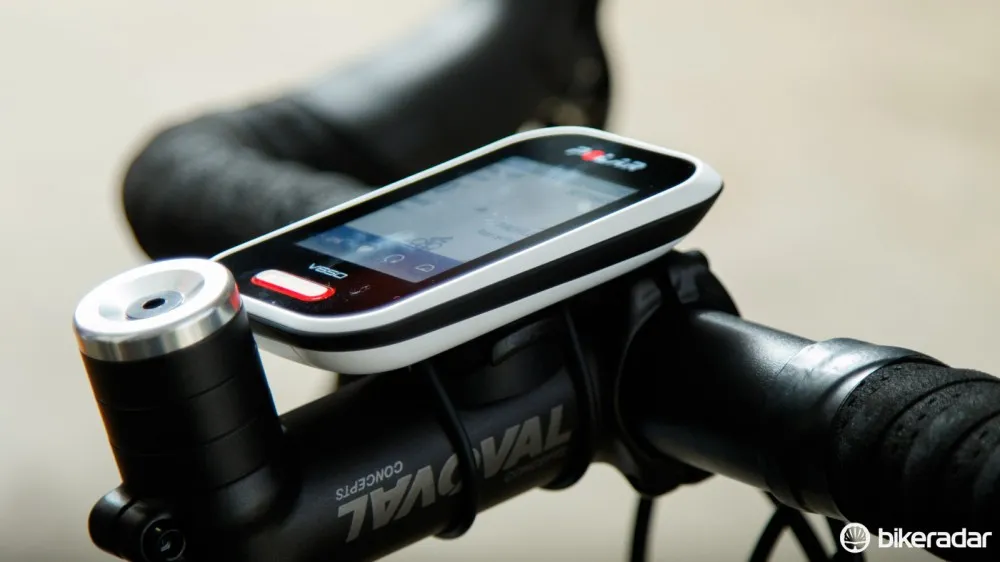
The V650 is a good looking unit, so much so that it earned a Red Dot Design award
The V650 has taken some obvious design cues from the smartphones we know and love. The central ‘home’ button doubles as the start and stop button (held down) and lap button (tapped), while a side button brings up a sub-menu for screen lock, altitude calibration, searching for sensors and turning the unit on and off.
The V650 also features an Android-esque pull down menu where screen brightness, alert sound volume, and safely light settings can be easily adjusted.
Weighing 118g, the unit features a 2.8in high contrast colour touch screen. Touch sensitivity is similar to a mobile and isn’t troubled by full finger or insulated gloves. The added screen size allows for a wealth of information to be displayed in a large easy-to-read font, and the always on backlight makes the screen visible in everything from bright sunlight to complete darkness.
Utilising a familiar quarter turn mounting system, the computer and mount feature ridges that keep it securely planted in the mount. Despite their visual similarities, the V650 will not fit into a Garmin mount — the circumference of the Polar mount is a few mm larger than Garmin’s.
Features
The Polar V650, like many of its competitors, is a useful training tool and is capable of recording more metrics than most cyclists will know how to interpret. Covering all the major data fields, such as time, speed heart rate, distance, and power, it does almost everything you could want from a cycling computer.
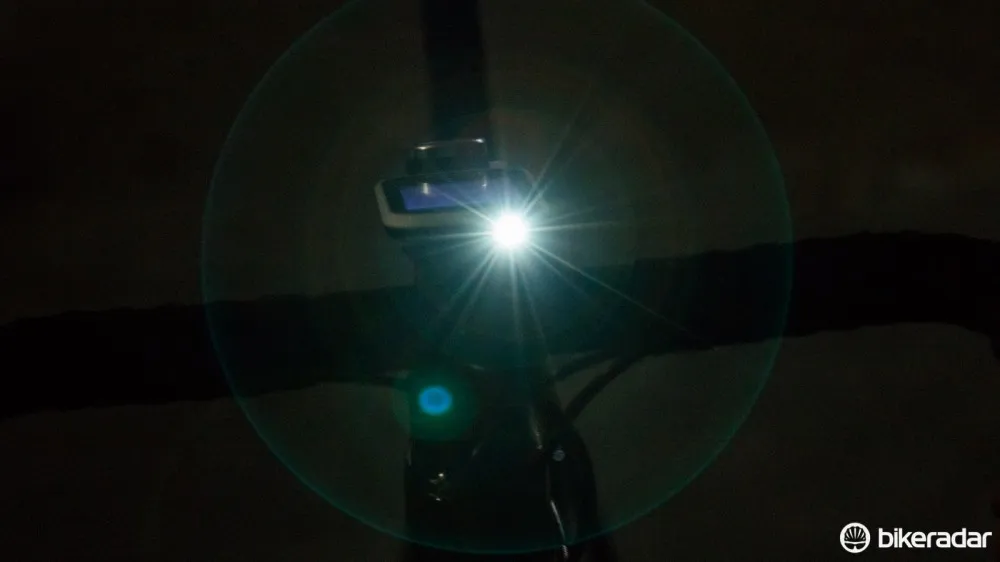
This photo exaggerates the actual brightness of the integrated light, it's not *quite* that dazzling
One nifty feature is the front safety light. In its default setting, a small LED comes on automatically in low light situations. It’s not nearly bright enough to serve as a standalone light, but will help with visibility if you’re stuck in a bind. Additionally, via the quick settings pulldown menu the light can be toggled into flashing and always-on modes, although these will unsurprisingly have an effect on battery life.
Polar claims that battery power should last 10 hours. We found that's about what we got out of a charge with the safety light set to the automatic setting, screen brightness at 100 percent, and GPS running.
The V650’s lack of turn by turn directions comes as something of a surprise. The device does feature a ‘back to start’ function, which is essentially a digital compass providing a heading which takes you back to the start of your ride. Polar has told us it plans to add open street maps (OSM), but could not give us a timeline for this.
The V650 is, however, Bluetooth Smart enabled. We had no trouble pairing the device to both Polar branded and third party Bluetooth-enabled heart rate straps and speed and cadence sensors.
At the time of our testing, Polar had only just released a firmware update allowing for support of its own Look KéO Bluetooth Smart Power Pedals. While the V650 recognised our Stages power meter, it would not pair with the unit. Polar has since confirmed that, at the time of writing, the V650 is not yet compatible with third-party power meters. Forgoing ANT+ connectivity, it’s perhaps this lack of greater compatibility that’s most disappointing in the V650’s purpose as a high-end cycling computer.
The Polar V650 also lacks the ability to display push notifications from your phone, despite its Bluetooth Smart connectivity – a feature that’s also pencilled in for a ‘future firmware update’.
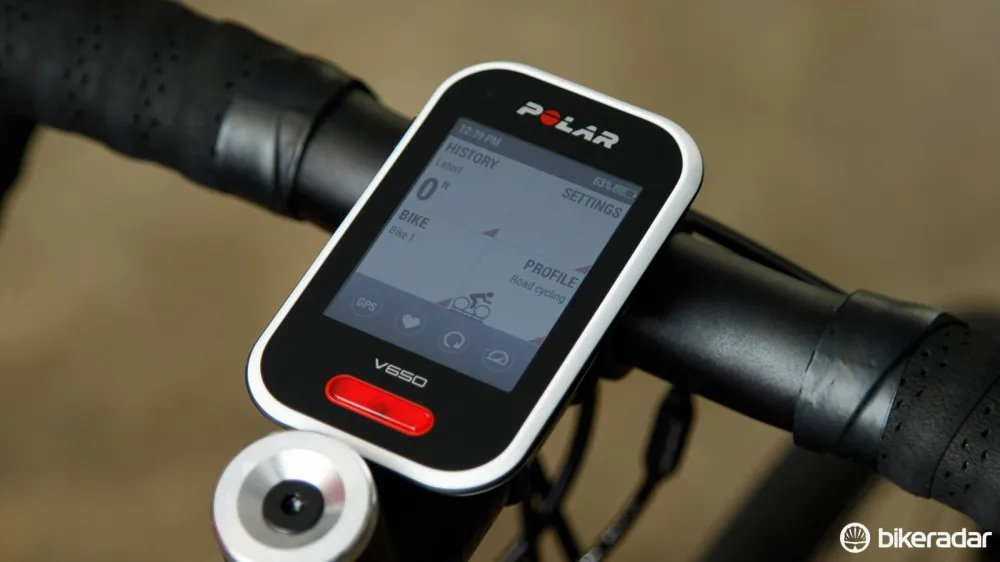
The V650's home screen is straightforward, but there's quite a bit going on here
The V650’s home screen features four boxes that allow you to see your riding history, access the settings menu, choose a riding profile, and specify one of up to four different customisable bike settings. A status bar along the bottom of the screen shows icons for GPS, heart rate, cadence and speed. If the icon has a green circle around it, the sensor is connected and ready to go. If it's blinking, the V650 is still searching for a previously paired sensor.
Because different riding situations warrant a unique set of data fields, the V650 has four different customisable riding profiles, and four bike settings. The riding profiles can be tailored to display only the metrics you want to see – you probably don’t want to know speed and distance riding the turbo trainer, but you do out on the road – and bike settings tell the unit which sensors to search for. This means the V650 won’t drain its battery searching the power meter on your road bike, while you’re riding your mountain bike.
The unit can display up to six ‘training views’ (pages) and each page can handle up to eight data fields. Some of the latter, like speed, altitude, and heart rate, can be displayed as visualisations. It’s here that the large screen size comes into its own, with the fields far more easily visible than on more compact units.
These aren’t groundbreaking features. But we found the heart rate visualisation particularly useful riding the turbo trainer, because it offers a live breakdown of how much time has been spent in each heart rate zone.

The Smart Coaching feature offers a visualisation of heart rate performance and and explanation of what the graph means
When an activity is finished, the Smart Coaching feature displays and analyses the HR breakdown and provides instant feedback on what areas the workout trained.
Key features compared with direct market competitors:
table { }td { padding-top: 1px; padding-right: 1px; padding-left: 1px; color: black; font-size: 12pt; font-weight: 400; font-style: normal; text-decoration: none; font-family: Calibri,sans-serif; vertical-align: bottom; border: medium none; white-space: nowrap; }.xl63 { font-weight: 700; }.xl64 { text-align: center; }.xl65 { color: rgb(34, 34, 34); font-family: Calibri; text-align: center; }.xl66 { color: rgb(51, 51, 51); font-family: Calibri; text-align: center; }.xl67 { color: windowtext; font-family: Calibri; text-align: center; }.xl68 { text-align: center; }
Array
Accuracy

We tested the V650 against an Edge 500 and had some interesting findings
As a baseline for accuracy we tested the V650 against our trusty Garmin Edge 500. Both computers were connected to a corresponding heart rate monitor and were running off of GPS connectivity.
Heart rate as we expected was the same on both units, and tracked accordingly with no lag from the Polar. Interestingly though, the Polar seemed to read on average 1mph faster than the Garmin, while the total distances remained the same. Also, the default auto pause on the Garmin seems to be set to a lower speed than the V650’s default, meaning the Edge 500 would restart sooner after leaving a stop light. A search through the V650’s settings menus revealed this feature can be customised.
The V650 also features what Polar calls Own-Cal / Smart Calories. Polar claims its system is the "most accurate calorie counter on the market [and] calculates the number of calories expended during a training session based on your weight, height, age, gender, your individual maximum heart rate (HRmax) and how hard you’re training”. We found that the V650 reported 10 percent more calories on average than the Edge 500 – neither computer was connected to a power meter during our testing.

Polar's heart rate strap is a good one, perfectly comfortable in use and easily adjustable
Our test unit came as a bundle with Polar’s high-quality Bluetooth enabled heart rate strap (the bundle sells for £210 / US$319 / AU$449). Separate speed and cadence sensors are available (which use magnets).
We can't help but wonder though why Polar hasn’t combined the two, because the system only adds more accessories to your frame, and another battery to change. The V650 will connect to third party Bluetooth speed and cadence sensors like the Wahoo Blue SC or Bontrager’s DuoTrap S (suits Trek bikes only), and in our opinion this is a much cleaner solution.
Also, the V650 cannot determine incline without the speed sensor (or Wahoo Blue SC and similar sensors). Polar has confirmed this is to ensure accuracy, but it’s an included metric offered by all of its closest competitors without the need for such a sensor.
Connectivity

Want to put your ride on Strava? It's not easy
Like Garmin, Polar has its own training software – called Polar Flow – which is similar to many other online training platforms.
We like the look of Polar Flow, and if you’re happy to make the swap, then the V650 takes full advantage of all the features available on the site. However, if you plan to keep using Strava, Training Peaks, or something else, Polar has made uploading your activities to these sites clunky.
Instead of allowing your computer to access the V650 as a storage device, as Garmin does, you need to download a desktop application called Flow Sync to upload your activities to Polar Flow. Once the activities have been uploaded to Polar Flow, you can log on and export your activity as a TCX file, and then upload to Strava or similar.
According to Strava tech support, it has made its API available to Polar, so the ball is in the Finnish firm's court. Polar has told us it plans to streamline this process in a future update, scheduled for late 2015.
Conclusion
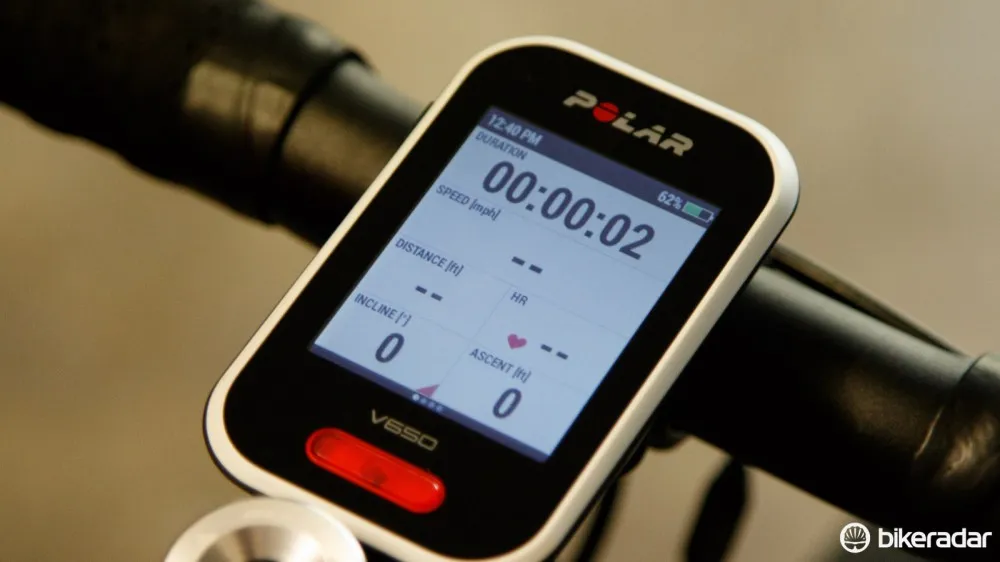
The V650 has all the right hardware, but is plagued by features 'scheduled for future firmware updates'
Polar’s re-entry into the cycling computer market has been long awaited. With its pedigree in HR and GPS enabled multisport watches we had high hopes for the V650, but we cannot help but feel the unit was rushed.
Many of the features that make the competing Garmin and Magellan/Mio units desirable are missing or pegged for ‘future firmware updates.’ When some of these updates come to fruition, the V650 will be a much more complete unit and at a highly competitive price, but for the moment Polar seems to be playing catchup.
Bluetooth is fast growing in popularity, but right now ANT+ remains the industry standard for those wanting to use a power meter in their training. For this, the V650 is perhaps competing most closely with the likes of the Today’s Plan, Wahoo or Strava smartphone apps.
Take power meter compatibility as an example – as it stands the unit is only usable with Polar's own system. So for those who already own a Bluetooth Smart meter such as Stages, 4ii, or an ANT+ unit, the V650 won’t work – and Polar’s power meter also locks you into Look pedals.
While Polar isn’t known to be a GPS heavyweight like Garmin or Magellan, even our venerable Edge 500 (not known for mapping) offers better mapping capabilities to those currently available in the V650. And then the smartphone in your pocket further embarrasses the V650’s navigation capabilities.
Nonetheless, it’s well priced (in the UK and US) and features such as the safety light, accurate altitude measurement and high resolution screen show Polar is close to a competitive head unit, if it can just sort out its firmware. Polar appears to be focused on heart rate training, which the unit does very well, but riders who incorporate power into their workouts should probably look elsewhere – for now at least.

